Wisconsin Bear Hunter
By Dick Ellis
Dear Wisconsin Bear Hunter,
Change is easier to see when looking back and the Wisconsin bear population and some season stats are no exception.
The following story from August 2008 focuses on bear baiting in Bayfield County in preparation for the Wisconsin season in September. I followed Guide Mike Foss on his daily trek to replenish bait sites in an effort to habitually bring bears to where hunters will wait on stand.
In an interview July 9, 2012 with Wisconsin Assistant Bear Biologist Scott Roepke, the Wisconsin bear population today is believed to number between 26,000 and 40,000 animals. A few years ago when this column was written the population was expected to increase drastically from an estimated 13,000 bears. A stable annual number of 73,000 applicants for a kill tag has grown to over 100,000 in 2012, Roepke said. 9,015 harvest permits were issued for this year’s hunt.
In 2011, according to Roepke, Wisconsin zone A hunters harvested 1592 bears, Zone B hunters tagged 969 bears, Zone C hunters took 715 bears, and Zone D hunter tagged 975 bears. The 4,257 total Wisconsin harvest was second only to the 2010 record kill of 5,133. We will regularly post information on the upcoming September hunt on this site from the DNR, with help from Roepke and his supervisor, Kevin Wallenfang.
With the exception of the use of dogs, baiting is virtually the only way to harvest bears, which interfere with human when population rises to “nuisance” levels. In addition to my own camera work, Photos #01 and #02, showing a black bear and apparently sick timber wolf, were taken by trail cameras mounted by Foss on the bait sites.
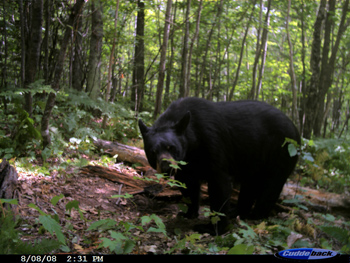 |
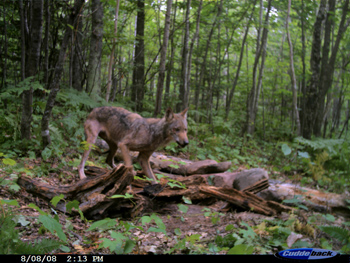 |
| A black bear is captured by a trail camera triggered by motion mounted on a tree at one of the Mike Foss 23 bait sites on public and private land in Bayfield County. | A lone Wisconsin timber wolf apparently suffering from mange and seeking food scraps is caught on motion camera at a Mike Foss bear bait site. |
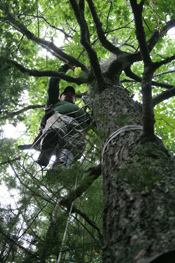 |
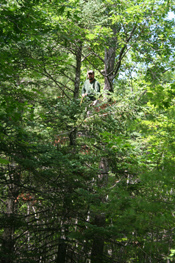 |
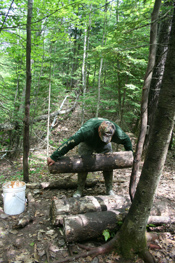 |
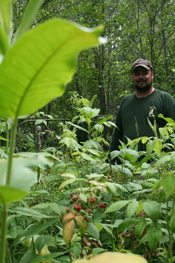 |
| When Bear Guide Mike Foss has permission to hunt on private land in Bayfield County, work includes cutting out treestands over bear bait sites for clients. | When Bear Guide Mike Foss has permission to hunt on private land in Bayfield County, shooting lanes for clients hunting over bait station must be cut to accommodate either bow and arrow, or firearm. | Bear Guide Mike Foss completes baiting another site by rolling logs over the sweets that will prevent deer or scavengers from raiding the bait but which can also easily be thrown aside by a hungry bear. | Near one of Mike Foss bear bait sites in Bayfield County, this berry patch showed evidence of hungry bears stopping for a bit of nature’s own snacks. |
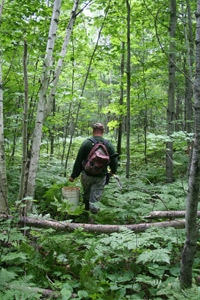 |
|||
| Wisconsin Bear and Deer Guide Mike Foss carries a pail of goodies to replenish one of his bear bait sites in Bayfield County in preparation of the September season. | |||
ORDER UP…Bear baiting routine means filled tags
By Dick Ellis
A Wisconsin bear guide’s work begins months before the first hunter steps foot in camp for the September season. For Mike Foss of Washburn near Lake Superior, diligent attention to making sure black bears habitually return to 23 bear bait sites spread over 35 square miles of rugged Bayfield County backcountry meant that hunters in 2007 realized a success rate of 88 percent.
Fifteen hunters will come to Foss’s Northern Wisconsin Outfitters in early September carrying high hopes and, it is expected, the proficiency with a firearm to quickly dispatch a Wisconsin black bear. They will carry rifles, shotguns, muzzleloaders, compound bows, traditional archery equipment, and handguns. Regardless of that choice, each will rely heavily on Foss, his associate guides and a lone apprentice to bring the bear to them via the animal’s tremendous sense of smell and ferocious appetite.
With the exception of using hounds, baiting is the only way to successfully hunt bear. Most regular visitors to rural regions of Wisconsin have never even seen the shy and often nocturnal black bear in the wild, although a two-year cooperative study of Wisconsin black bears coordinated by the DNR suggest that the population may actually be about two times, or more, higher than the currently embraced estimate of 13,000.
Currently, bear hunters wait on average seven seasons to receive a kill permit. More than 73,000 hunters applied for and received either a harvest permit or preference point over the last several years, the highest numbers of applicants since the quota system was adopted in 1986. The number of harvest permits has remained relatively unchanged over the last several years. However, due to the increased number of applicants, hunters now need four to nine preference points depending on zone before they receive a Class A permit to actually hunt.
If a drastic bear population increase is verified in the coming season, it’s probable that a sharp increase in harvest permits will be issued to Wisconsin bear hunters in the near future Regardless of the number of bears or permits issued, working to replenish bait sites with non-animal or animal bi-products like pie filling, pastry or candy treats like gummy bears is necessary to bring the animal to the hunter. Guides and individual hunters alike are working hard to bait and rebait in these last weeks before the season opener.
The 2008 season for bait hunters in Zone C begins September 3 and continues through October 8. In Zone A, B and D, bait hunters enjoy one week of hunting without competition, and then are joined by hound hunters September 10 through the 30. October 1-7 is restricted to hunting with dogs only.
Harvesting bears is imperative, according to state game managers, to keep the population from increasing to “nuisance” levels at which bears conflict with humans as they continually roam in their search for more food. One such common complaint pertains to the animals’ raids on bird feeders.
Four closely regulated bear harvest zone, A, B, C, and this year for the first time, D (eliminating Zone A1), assure that the population is kept in check. The 2007 harvest for Zone A was 1,020 bears, for Zone B was 513, Zone C was 565, and zone A1 (or D), 697. 2008 permits issued include 1440 in Zone A, 850 in Zone B, 1650 in Zone C and 720 in Zone D.
Bait hunters could legally begin baiting bears on April 15, almost five months prior to the season opener, and continue through the end of the season. Most hunters do not begin to bait that early, but professional guide Foss is baiting his 23 sites on public and private land (with permission) by May. He will initially bait once or twice per week, but increase the routine to three times weekly one month before the season.
With plans to visit the Foss bear camp in September as an observer, I accepted an invitation to also bait with Foss in late July. The work is hard and hot in thick foliage with swarms of mosquitoes also ready to answer the dinner bell. Foss carries bait and a can of bear spray in the highly unlikely event of an attack. But, even when trailing a hit bear during the black of night in thick vegetation, regulations also dictate that he carry only spray and not a firearm for protection.
“Don’t worry Mike, I’m right behind you,” I tell the guide during the regular season. “I mean…I’m way behind you.”
Our circuit of several bear sites was traveled on two Foss ATVs. We then parked, and walked into each bait site with Foss carrying a pail of goodies to replenish the bait pits. Inevitably, the sites had been hit by bears, with logs used to seal the meal from deer and scavengers scattered around like toothpicks. After the bait was set, the logs were replaced and we would move on.
Cameras mounted on trees and fixed on the bait sites add to the fun. Motion triggers the photo, and we then are able to view how big the bears are that are visiting. With 300 pound plus bears and bigger harvested annually in the Foss camp and monstrous Wisconsin bears out there roaming, viewing the photos offers its own kind of excitement. Recently, in addition to the bears a lone timber wolf apparently with mange seeking scraps at one site was also captured.
Foss said that the Wisconsin bear season is a necessary management tool within a precise management program that prevents the population from exploding. With high bear numbers, he said, more and more bears not dominant in certain territories migrate to central and southern regions of Wisconsin where they would not be under more normal conditions. Those areas are often urban and heavily populated by humans.
“That means we see more nuisance bears in conflict with humans,” Foss said. “They get in garbage and bird feeders for example. And once a nuisance bear, always a nuisance bear. Even if they are trapped and relocated, they’re going to get into trouble again.”
Northern Wisconsin Outfitters also offers guided hunts for whitetail deer on public land in Wisconsin’s far north. Contact them at www.northernwisconsinoutfitters.com or 1-715-373-0344.









